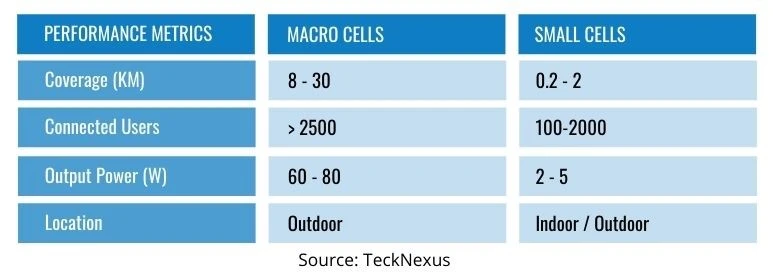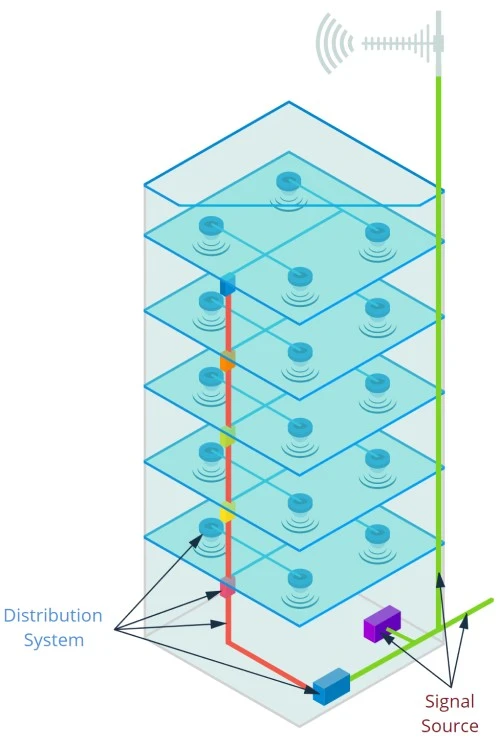- Article & Insights
- November 9, 2024
- Hema Kadia
Explore Private Networks characterstics, benefits, ecosystem players and the top industry verticals leveraging private networks.
Home » 5G Magazine » 5G Tower, Small Cells, DAS Edition | 5G Magazine » 5G Cells – What are Macro cells, Small Cells and DAS?
5G operates across a wide spectrum of bandwidth and supports a varied number of use cases. This wide spectrum will allow wireless carriers to conceptualize a large number of deployment options to suit their needs. 5G will operate in two frequency ranges – Frequency Range 1 (FR 1- 410MHZ to 7.1 GHz) and Frequency Range 2 (FR2 -24.25Ghz – 52.6 GHz). Deployment options for wireless carriers can range from Macro Cells (for coverage) to small cells (for capacity).
Wireless carriers will consider capacity, coverage, mobility, and spectrum availability to decide their deployment strategies to determine whether they will go for Macro and Small cells. Let us now understand the definitions of Macro Cell and Small Cell.
Macro Cell: Macro Cell typically provides coverage to a large geographic area. They are typically installed on rooftops, poles, and in some instances, on Ground-Based Towers. The major advantage of using Macrocell in 5G is that it can provide 5G services to a large geographic area. 5G macro cells also use Massive MIMO technology, which allows large transmission and reception of data.
Small Cell: Small Cell has been used to deploy legacy technologies like 3G and 4G and would play a more important role in 5G deployment. It will empower wireless carriers to deploy cell sites in strategic locations and offer higher capacities in the small coverage area.

Femto Cell: Femto cells are small mobile base stations that are used to extend coverage in the residential or small office complexes. They are used in areas with network congestion, and it acts to offload a Macro Cell. It can also serve to provide in-building coverage.
Pico Cell: Pico Cells are small cellular base stations covering areas like buildings, hotels, hospitals, and shopping malls. It is generally used to extend coverage and increase throughput.
Micro Cell: Microcells are generally a bit bigger in comparison to Pico and Femto Cells. They can support more no of connected users and cover a greater geographic area. They are mostly used for enterprise premises.
The small cell market size is expected to grow from USD 626 million in 2020 to USD 2413 million by 2025, as per the research by MarketsandMarkets firm.
One of the major drivers of the small cell market is the introduction of CBRS (Citizen Broadband Radio Service) in private networks. Both LTE and 5G private network is gaining business potential which can beef up small cell deployment. With mm-Wave 5G deployment taking shape of commercial network deployment, small cells will play a major role in paving the success story of 5G use cases.
But the major challenge in the rapid small cell deployment will be the backhaul connectivity. The small cell will be deployed to cater to increase capacity in residential or enterprise premises where commissioning of fiber can be a challenge. If proper bandwidth at backhaul is not available, it can be a potential bottleneck. Therefore, to tackle the issue of backhaul, the wireless carriers need to think of alternate backhaul options like satellite, high-capacity Microwave.
One of the major opportunities for small cells is that since the transmitted power for small cells is quite low the Mobile terminals will also need to operate in small powers, which will enhance the better battery life of the UEs. This will improve the performance of the mobile handsets too.
Distributed Antenna System and Small Cells both complement each other in 5G deployment in private and enterprise space. DAS is a network of antennas that are connected to a common RF source and then distributed to a customer premise. They are generally used in large sporting stadiums or events where there is high densification of cellular networks.
A DAS is made up of two components, Signal Source and Distribution System.

Single Source: A distributed antenna system can’t generate signals on its own. Instead, it needs a signal source that needs to be fed to the antenna system, which is then distributed to the entire customer premise. The source can be an RF module of a wireless carrier, or it can be a small cell too. The signal source is one of the key factors in the coverage and capacity metric of DAS. A DAS system can have an excellent distribution system, but it will be of no use if the signal source is not efficient.
Distribution System: Once the signal source is generated it needs to be amplified and distributed in the customer premise. It can be distributed via active, passive, hybrid and digital distribution technologies. A distributed antenna system’s performance (i.e. capacity and coverage) depends on the type of technology it uses.
Converts RF signals from source to distribute over optical fiber or ethernet cable. If the signal comes from multiple sources, a master unit combines them to distribute it as a digital signal. The digital signal is transmitted over fiber or ethernet cable to the Remote Radio Units (RRUs). The RRUs, also referred to as nodes or active antennas, convert the signal back to RF. Active DAS is comparatively more expensive than hybrid and passive systems.
It uses passive RF components like splitters, coaxial cables to distribute the signals. There will be more attenuation in the power broadcast if the antenna is away from the single source & amplifiers. Hence, it is not preferred to have long runs of cable. Passive DAS has low cost because it does not require an analog-to-digital converter, and no additional equipment is required to support multiple carriers.
Hybrid DAS uses features of active and passive DAS. Since the RRUs are separate from the antennas, hybrid DAS can use both fiber and coaxial cable. It includes RRU on each floor, which converts the digital signal to an analog signal. The analog signal further connects to multiple antennas with coaxial cable on the same floor. It is expensive than passive DAS but cheaper than active DAS. The installation of hybrid DAS is complicated as it requires both coaxial and fiber cables.
It converts analog signal to digital signal and then transports over coaxial or fiber cable to the antennas. The conversion & combination process makes digital DAS an expensive option, but it is less susceptible to interference. Additionally, the digital DAS platform allows the capacity of the signal sources to be directed to different areas as needed.


